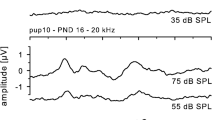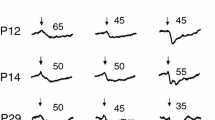Summary
This report describes the ontogenesis of tonotopy in the inferior colliculus (IC) of the rufous horseshoe bat (Rhinolophus rouxi). Horseshoe bats are deaf at birth, but consistent tonotopy with a low-to-high frequency gradient from dorsolateral to ventromedial develops from the 2nd up to the 5th week. The representation of the auditory fovea is established in ventro-mediocaudal parts of the IC during the 3rd postnatal week (Fig. 3). Then, a narrow frequency band 5 kHz in width, comprising 16% of the bat's auditory range, captures 50–60 vol% of the IC (Fig. 3c). However, foveal tuning is 10–12 kHz (1/3 octave) lower than in adults; foveal tuning in females (65–68 kHz) is 2–3 kHz higher than in males (62–65 kHz). Thereafter, foveal tuning increases by 1–1.5 kHz per day up to the 5th postnatal week, when the adult hearing range is established (Figs. 4, 5). The increase of sensitivity and of tuning sharpness of single units also follows a low-to-high frequency gradient (Fig. 6).
Throughout this development the foveal tuning matches the second harmonic of the echolocation pulses vocalised by these young bats. The results confirm the hypothesis of developmental shifts in the frequency-place code for the foveal high frequency representation in the IC.
Similar content being viewed by others
Abbreviations
- BF :
-
best frequency
- CF :
-
constant frequency
- FM :
-
frequency modulation
- IC :
-
inferior colliculus
- IHC :
-
inner hair cell;
- OHC :
-
outer hair cell
- RR :
-
Rhinolophus rouxi
References
Aitkin LM, Moore DR (1975) Inferior colliculus. II. Development of tuning characteristics and tonotopic organisation in central nucleus of neonatal cat. J Neurophysiol 38:1208–1216
Bruns V, Schmieszek E (1980) Cochlear innervation in the greater horseshoe bat, demonstration of an acoustic fovea. Hearing Res 161:29–50
Carlier E, Pujol R (1978) Role of inner and outer hair cells encoding sound intensity: an ontogenetic approach. Brain Res 147:174–176
Casagrande VA, Condo GJ (1988) The effect of neural activity on the development of layers in the lateral geniculate nucleus. J Neurosci 8:395–416
Clopton BM, Winfield JA (1976) Effect of early exposure to patterned sound on unit activity in the rat inferior colliculus. J Neurophysiol 39:1081–1089
Cody AR, Russel IJ (1987) The responses of hair cells in the basal turn of the guinea pig cochlea to tones. J Physiol 383:551–569
Cody AR, Russel IJ (1988) Acoustically induced hearing loss: Intracellular studies in the guinea pig cochlea. Hearing Res 35:59–70
Dallos P, Harris D (1978) Properties of auditory nerve response in absence of outer hair cells. J Neurophysiol 41:365–388
Dixon WJ, Mood AM (1946) The statistical sign test. J Am Stat Assoc 41:557–566
Echteler SH, Arjmand E, Dallos P (1989) Developmental alteration in the frequency map of the mammalian cochlea. Nature 341:147–149
Ehret G (1977) Postnatal development in the acoustic system of the house mouse in the light of developing masked thresholds. J Acoust Soc Am 62:143–148
Evans EF (1975) Cochlear nerve and cochlear nucleus. In: Keidel WD, Neff WD (eds) Auditory system. (Handbook of sensory physiology vol 5/2) Springer, Berlin Heidelberg New York, pp 1–108
Harris DM, Dallos P (1984) Ontogenetic changes in frequency mapping of a mammalian ear. Science 225:741–743
Hyson RL, Ruby JW (1986) Ontogenetic change in the analysis of sound frequency in the infant rat. Dev Psychobiol 20:189–207
Irvine DRF (1986) The auditory brainstem. In: Ottoson D (ed) Progress in sensory physiology, vol 7. Springer, Berlin Heidelberg New York
Kim DO (1985) Functional roles of the inner- and outer-hair-cell subsystems in the cochlea and brainstem. In: Berlin C (ed) Hearing science. College Hill Press, San Diego, pp 241–262
Kraus HJ, Aulbach-Kraus K (1981) Morphological changes in the cochlea of the mouse after the onset of hearing. Hearing Res 4:89–102
Liberman MC (1982) The cochlear frequency map for the cat: labeling auditory-nerve fibers of known characteristic frequency. J Acoust Soc Am 72:1441–1449
Lippe WR (1987) Shift of tonotopic organisation in brainstem auditory nuclei of the chicken during late embryonic development. Hearing Res 25:205–208
Moore DR, Irvine DRF (1979) The development of some peripheral and central auditory responses in the neonatal cat. Brain Res 162:49–59
Peters A (1987) Analyse der Frequenzrepräsentation im Innenohr der echoortenden Fledermaus Hipposideros lankadiva. Dissertation, University of Munich
Pujol R, Carlier E, Lenoir M (1980) Ontogenetic approach to inner and outer hair cell function. Hearing Res 2:423–430
Retzius G (1884) Das Gehörorgan der Wirbeltiere: II. Das Gehörorgan der Reptilien, der Vögel und der Säugetiere. Samson and Wallin, Stockholm
Romand R (1983) Development of the cochlea. In: Romand R (ed) Development of auditory and vestibular systems. Academic, New York, pp 47–88
Romand R, Marty R (1975) Postnatal maturation of the cochlear nuclei in the cat: A neurophysiological study. Brain Res 83:225–233
Rubel EW, Lippe WR, Ryals BM (1984) Development of the place principle. Ann Otol Rhinol Laryngol 93:609–615
Rubel EW, Born DE, Deitch JS, Durham D (1985) Recent advances toward understanding auditory system development. In: Berlin C (ed) Hearing science. College Hill Press, San Diego, pp 109–157
Rübsamen R (1987) Ontogenesis of the echolocation system in the rufous horseshoe bat, Rhinolophus rouxi. (Audition and vocalization in early postnatal development). J Comp Physiol A 161:899–913
Rübsamen R, Neuweiler G (1987) Postnatal development of frequency maps in the central auditory system of hipposiderid CF-FM bats. In: Elsner N, Creutzfeldt OD (eds) New frontiers in brain research. Proc 15th Göttingen Neurobiol Conf, Thieme, Stuttgart, p 116
Rübsamen R, Schäfer M (1990) Audio-vocal interactions during development? Vocalisation in deafened young horseshoe bats vs. audition in vocalisation-impaired bats. J Comp Physiol A 167:771–784
Rübsamen R, Neuweiler G, Sripathi K (1988a) Comparative collicular tonotopy in two bat species adapted to movement detection, Hipposideros speoris and Megaderma lyra. J Comp Physiol A 163:271–285
Rübsamen R, Schäfer M, Neuweiler G (1988b) Spatial frequency representation in the auditory midbrain of the rufous horseshoe bat Rhinolophus rouxi. In: Elsner N, Creutzfeldt OD (eds) New frontiers in brain research, Proc 15th Göttingen Neurobiol Conf. Thieme, Stuttgart, p 196
Rübsamen R, Neuweiler G, Marimuthu G (1989) Ontogenesis of tonotopy in inferior colliculus of a hipposiderid bat reveals postnatal shift in frequency place code. J Comp Physiol A 165:755–769
Ryan AF, Woolf NK (1988) Development of tonotopic representation in the mongolian gerbil: a 2-desoxyglucose study. Dev Brain Res 41:61–70
Sanes DH, Merickel, Rubel EW (1989) Evidence for an alteration of the tonotopic map in the gerbil cochlea during development. J Comp Neurol 279:436–445
Saunders JC, Dolgin KG, Lowry DL (1980) The maturation of frequency selectivity in C57bl/6J mice studied with auditory evoked response tuning curves. Brain Res 187:69–79
Schnitzler HU (1968) Die Ultraschall-Ortungslaute der Hufeisenfledermäuse (Chiroptera-Rhinolophidae) in verschiedenen Orientierungssituationen. Z Vergl Physiol 57:376–408
Schuller G, Pollak G (1979) Disproportionate frequency representation in the inferior colliculus of Doppler compensating greater horseshoe bats. Evidence for an acoustic fovea. J Comp Physiol 132:47–54
Schuller G, Beuter K, Schnitzler HU (1974) Response to frequency shifted artificial echoes in the bat, Rhinolophus ferrumequinum. J Comp Physiol 89:275–286
Schuller G, Beuter K, Rübsamen R (1975) Dynamic properties of the compensation system for Doppler shifts in the bat, Rhinolophus ferrumequinum. J Comp Physiol 97:113–125
Schweitzer L, Cant NB (1984) Development of the cochlear innervation in the dorsal cochlear nucleus of the hamster. J Comp Neurol 225:228–243
Sellick PM, Patuzzi R, Johnstone BM (1983) Comparison between the tuning properties of inner hair cells and basilar membrane motion. Hearing Res 10:93–100
Sterbing S, Rübsamen R, Schmidt U (1990) Auditory midbrain frequency-place code and audio-vocal interaction during postnatal development in the phyllostomid bat, Carollia perspicillata. In: Elsner N, Roth G (eds) Gehirn — Wahrnehmung — Kognition. Proc 18th Göttingen Neurobiol Conf. Thieme, Stuttgart, p 140
Tokimoto T, Osako S, Matsuura S (1977) Development of auditory evoked cortical and brain stem responses during the early postnatal period in the rat. Osaka City Med J 23:141–153
Trune DR, Morgan CR (1988) Influence of developmental auditory deprivation on neuronal ultrastructure in the mouse anteroventral cochlear nucleus. Dev Brain Res 42:304–308
Vater M (1988) Lightmicroscopic observations on cochlear development in horseshoe bats. In: Nachtigall P (ed) Animal sonar systems. Plenum, New York, pp 341–347
Vater M, Rübsamen R (1989) Postnatal development of the cochlea in horseshoe bats. In: Wilson JP, Kemp DT (eds) Cochlea mechanisms. Plenum, New York, pp 217–225
Vater MJ, Feng AS, Betz M (1985) An HRP-study of the frequency-place map of the horseshoe bat cochlea: morphological correlates of the sharp tuning to a narrow frequency band. J Comp Physiol A 157:671–686
Young ED (1985) Response characteristics of neurons in the cochlear nuclei: In: Berlin C (ed) Hearing science. College Hill Press, San Diego, pp 423–460
Author information
Authors and Affiliations
Rights and permissions
About this article
Cite this article
Rübsamen, R., Schäfer, M. Ontogenesis of auditory fovea representation in the inferior colliculus of the Sri Lankan rufous horseshoe bat, Rhinolophus rouxi . J Comp Physiol A 167, 757–769 (1990). https://doi.org/10.1007/BF00189766
Accepted:
Issue Date:
DOI: https://doi.org/10.1007/BF00189766




